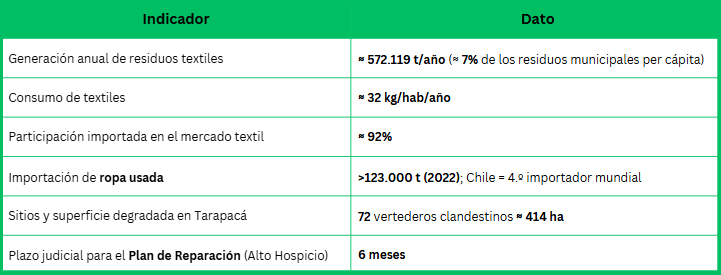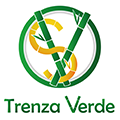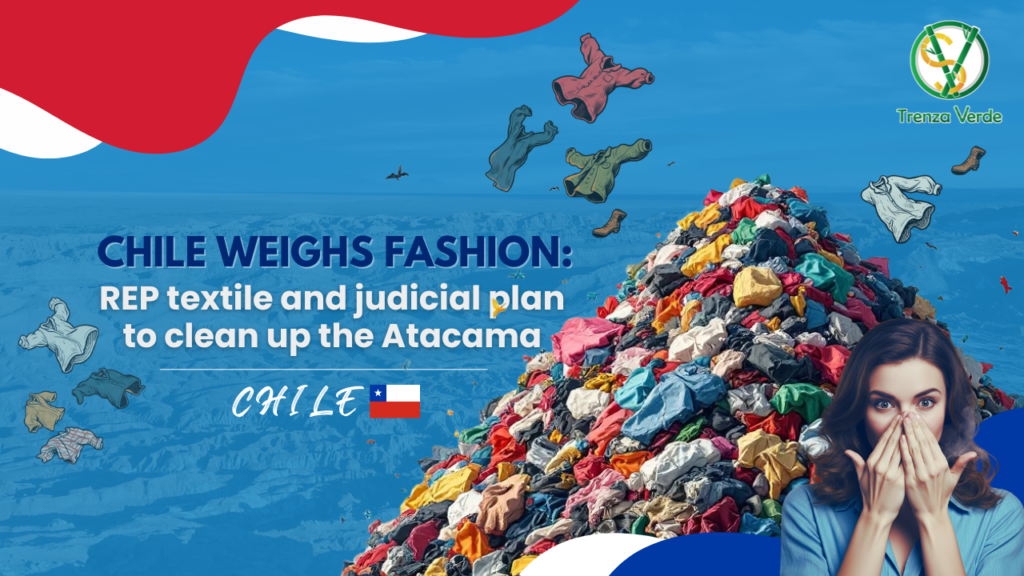In Chile, the problem of textile waste has stopped being “invisible” and moved to the center of public debate in recent years—especially after those viral 2021 images of clothing piled into mountains in the Atacama Desert (Alto Hospicio, Tarapacá). This didn’t happen overnight. For decades, the country has channeled a high volume of apparel—new items, surplus stock, and secondhand clothes—through the Iquique Free Trade Zone (ZOFRI). But the mix of fast fashion, overproduction, and lower-quality garments sped everything up and made end-of-life disposal practically unmanageable.
Structurally speaking, Chile already had a legal framework for waste management: Law 20,920, better known as the Extended Producer Responsibility (EPR) Law, enacted on June 1, 2016. However, textiles weren’t prioritized until 2025, when the Ministry of the Environment designated them the seventh “priority product” (Exempt Resolution 3914/2025, published July 4, 2025). From there, producers and importers were required to register in the RETC (the national emissions and transfers registry) and report the volumes they place on the market—opening the door to mandatory targets for collection and resource recovery (think reuse and recycling).
That’s why Chile has now officially named textiles as the seventh priority product under the EPR Law. The move paves the way for binding goals on collection and recovery, forces transparent reporting of what’s sold, and turns up the regulatory pressure on the used-clothing import chain—which topped 123,000 metric tons in 2022. At the same time, the courts have ordered the State to submit, within six months, a remediation plan to address the environmental damage caused by textile dumping in Alto Hospicio, in the Atacama Desert.
What exactly changed?
Textiles = priority product (EPR Law). Chile’s Ministry of the Environment (MMA) officially added textiles as a “priority product” under the Extended Producer Responsibility framework via Exempt Resolution No. 3914/2025, published in the Official Gazette on July 4, 2025. From now on, any company that places textiles on the market (think: sells or imports them) must register in the RETC (the national emissions and transfers registry) and report annual volumes. The MMA will also kick off a target-setting decree to define binding goals—like collection, recovery (reuse/recycling), and other compliance duties.
Remediation plan for Atacama. The First Environmental Court confirmed significant environmental damage from textile dumping at Pampa Norte, Pampa Sur, Mollecita Norte, and Mollecita Sur (Alto Hospicio). It ordered the State of Chile to submit a Remediation Plan within six months. What does that include? Removal and safe disposal of waste; site closure and containment; soil and landscape restoration; measures to prevent new dumping; community participation; and clear, verifiable targets. In short: real cleanup with real accountability.
The problem, by the numbers

Why is this a milestone for the circular economy?
- Costs get internalized and the market gets organized. Under EPR, the responsibility—and the bill—for managing textile waste shifts to producers and importers. That means clear targets, real oversight, and traceability throughout the system. The outcome? Less illegal dumping and fewer “buy it, use it once, toss it” habits.
- A data backbone and real control. Annual reporting to the RETC will map out the flows—by textile type—so the country can measure what’s coming in, what’s being recovered, and how well companies are meeting the targets the Ministry of the Environment will set in its decree.
- Social and economic ripple effects. Textile EPR opens up new business lines—reuse, repair, remanufacturing, and both mechanical and chemical recycling—plus local jobs in sorting, reverse logistics, and post-sale services. The MMA situates this move within a broader Textiles Circular Economy Strategy through 2040, which gives industry and communities a clearer road map.
- Aligned with environmental justice. The First Environmental Court’s ruling pushes the shift from diagnosis to action, with verifiable goals to clean up and restore affected areas. In other words, public policy (EPR) now lines up with on-the-ground repair measures—so communities see real progress, not just plans.
What’s next (regulated next steps)
EPR–Textiles Target Decree. The Ministry of the Environment (MMA) will kick off the process for a Supreme Decree that sets the rules of the game: product categories/sub-categories, binding targets for collection and recovery (reuse/recycling), and other duties like design for repair/reuse, nationwide coverage, drop-off points, and more. In short, this decree will spell out who does what, by when.
Immediate compliance for companies.
RETC registration + annual reporting. Any producer or importer of textiles must register in the RETC (the national pollutant release and transfer register) and declare annual volumes placed on the market.
Set up management systems with traceability. Companies need to prepare individual or collective systems to handle textile waste, ensuring end-to-end tracking so materials don’t get lost along the way.
Remediation Plan (Atacama).
Comprehensive site assessments to understand the full environmental impact.
Removal and safe disposal of waste, plus site closure/containment and ongoing oversight.
Soil and landscape restoration, with measures to prevent new dumping.
Public participation and transparent monitoring with verifiable targets, so communities can see—and check—real progress.
Key steps for businesses and municipalities (operational checklist)
Map your products. Identify whether your portfolio falls under “textiles” according to the preliminary definition in the resolution.
Register and report. Sign up in the RETC and get your inventories and sales/import certificates in order for annual declarations.
Design reverse logistics. Decide whether to join a collective management system, and plan for traceability and convenient drop-off points.
Prepare evidence. Track metrics for collection, recovery/value retention (reuse, repair, recycling), and reuse—this becomes the baseline for future targets and audits.
Coordinate locally. Work with municipalities and cooperatives to run repair/reuse pilots and help create local jobs across the circular chain.
Final reflection
If Chile’s experience shows anything, it’s that environmental irresponsibility isn’t an accident—it’s the sum of many omissions: producing without eco-design, importing without traceability, selling without owning the post-consumer stage, and enforcing rules without real teeth. And this isn’t an isolated case. For decades, too many countries—producers, exporters, and importers alike—have allowed the true costs of fast fashion and throwaway culture to be externalized onto deserts, riverbanks, and peripheral neighborhoods. The results are open-air dumps, emissions from illegal burning, contaminated soils and aquifers, and informal value chains stuck in precarious conditions.
Let’s be honest: some of the damage may be partly irreparable. But what is repairable—and urgent—is how we decide. Extended Producer Responsibility (EPR) isn’t an end in itself; it’s a basic standard: measure, report, reduce, reuse, repair, and recover—with clear targets and timelines. Without that, we’ll keep shifting the burden onto the same places and the same people.
Chile is opening a door: binding targets, traceability, and real remediation. The challenge is to make it more than a headline—let it spread as a standard regionally and globally: sustainable public procurement, effective customs controls on used-clothing flows, investment in mechanical and chemical recycling, formalization of recyclers, and radical data transparency. Because if a “business” only works when someone else picks up the environmental tab, it’s not a business—it’s a debt to the planet we can’t keep sweeping into the desert.
Sources and official documents
Resolución oficial (texto y Diario Oficial):
Res. Exenta N° 3914/2025 (MMA) – “Declara a los textiles como productos prioritarios…” (16-jun-2025, PDF). Economía Circular
Publicación en Diario Oficial (04-jul-2025): cifras de >123.000 t de ropa usada (2022), ≈92% importado, 72 sitios ≈414 ha, lineamientos para decreto de metas. Economía Circular
Comunicado del Ministerio del Medio Ambiente (24-jun-2025): 32 kg/hab/año, ≈572 mil t/año, obligaciones inmediatas (RETC y declaración). educacion.mma.gob.cl
Página temática oficial “Textiles – Economía Circular” (MMA): marco conceptual, cifras y relación con la Estrategia de Textiles al 2040. Economía Circular
Justicia ambiental – Atacama (sep-2025):
Primer Tribunal Ambiental (1TA) – “Se condena al Estado de Chile a la presentación de un plan de reparación…”; plazo 6 meses y medidas exigidas. 1ta.cl
Cobertura internacional reciente (contexto):
The Guardian (26-jun-2025): avance regulatorio y objetivo de erradicar vertederos textiles en el Desierto de Atacama. The Guardian

